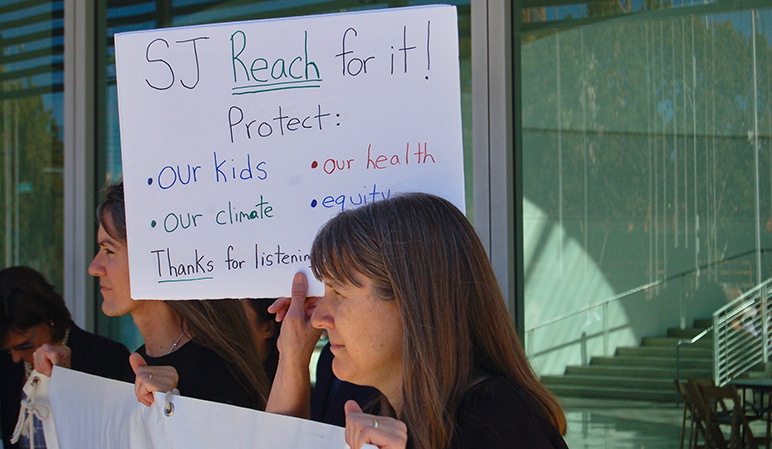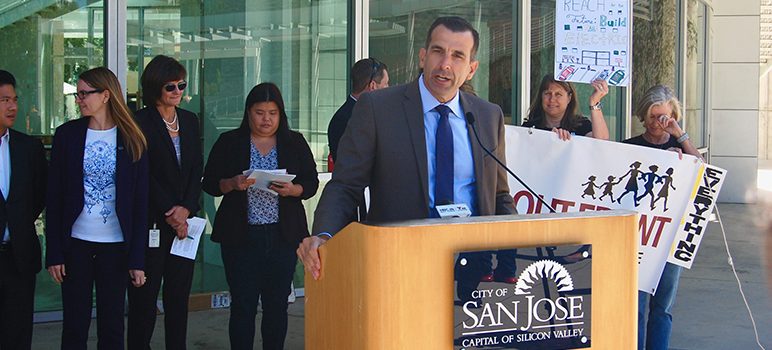As wildfires ravage vast swaths of California wildland and other parts of the globe increasingly feel the effects of climate change, San Jose is trying to ban natural gas in new construction and boost the number of electric car chargers in future developments.
The sustainability standards pitched by Mayor Sam Liccardo and City Council members Raul Peralez, Lan Diep, Magdalena Carrasco and Dev Davis are on track to become part of San Jose’s new building “reach codes.” If the California Energy Commission gives them the green light, they can go into effect when the clock strikes 2020.
While California has its own set of clean-energy regulations that developers must meet, cities can go a step further by enacting reach codes—basically rules that “reach” beyond statewide sustainability thresholds by making zero-emission electric building the standard. On Tuesday, that’s exactly what San Jose did in a unanimous council vote.
In so doing, it became biggest city in the US to adopt all-electrification requirements on new residential buildings and gas bans on commercial construction.
By early next year, developers may have to opt for electric appliances and other infrastructure in single-family homes, backyard cottages, low-rise buildings, apartments and condos. If all goes according to plan, the changes could cut greenhouse gas emissions in new buildings by up to 90 percent and save owners and tenants money on utility bills.
Liccardo and his colleagues also want to require 70 percent of parking spots in new apartments to at least have the infrastructure for charging ports, with another 20 already equipped for charging and the remainder reserved for “service equipment.”
The proposal aligns with the city’s Climate Smart San Jose plan—a Paris Agreement-aligned blueprint to harness clean energy and curb greenhouse gas emissions. The new reach codes would make San Jose the largest city in Santa Clara County to go electric.
“We are providing an example of the kind of concrete action that we can take today to confront a climate emergency and send a clear signal ... about our commitment to preserving our planet,” Liccardo said at a Tuesday press conference. “We are showing here through community leadership how we can confront this climate crisis, a crisis that has been largely ignored with the abdication of federal responsibility on this issue.”
Peralez echoed the mayor’s message.
“We’ve been able to move further than a number of other cities across the country and in fact achieve the top spot in our goals of reaching these sustainable development goals as well as just our goals combatting climate change,” he added.
Councilors are also requesting that the city explore funding, financing and partnerships that would offset costs for installing solar and battery storage and electric car infrastructure in new affordable housing. They’d also examine financing for electric appliances and take inventory of the electrification programs offered in California.
Environmentalists applaud the new restrictions.
In an interview ahead of the council vote, 15-year-old Helen Deng said she welcomes the new code because she “supports policies that will turn the tide on the climate crisis.”
“I don’t want to grow up knowing even more fossil fuels are becoming inextricable from societal structures, simultaneously risking my education to fight for climate action and other solutions,” she said in an interview with San Jose Inside. “There’s too much at stake, and if our own cities can’t pass ambitious reach codes, how can young people have hope for real action on the global scale?”
Councilwoman Sylvia Arenas praised community support for the initiatives—particularly that of young people who showed up to voice their concern about climate change.
“The next generation, they just get it,” she said approvingly. “They’re pushing us and I really like what you all had to say about reaching. Sometimes we have to reach further than what we anticipated.”
But some critics are worried about the impact the new rules would have on housing production. Erik Schoennauer, a local land-use consultant, called it a “noble cause,” but expressed worry about whether it would slow projects in the city’s development pipeline.
“New policies like this add new costs and new layers of complexity, especially on housing,” he said. “Whenever a new public policy is implement on development, there needs to be a transition period. Otherwise we risk delaying or killing projects.”
Councilman Johnny Khamis said he’s heard similar sentiments from a few developers. At his behest, the council ordered a cost analysis—specifically for backyard cottages.
“I talked to four developers before I came to the council meeting and they disagreed with the assertion that they were going to save with these regulations,” Khamis said. “My whole goal is to not increase the price of housing.”
City staff and Councilwoman Pam Foley said they believe improving energy efficiency through reach codes will actually save money in the end. The D9 representative was a strong supporter of the stricter building regulations, but due to certain open meeting laws, was unable to sign onto a memo supporting the proposal.
“In the long run, if a builder doesn’t have to put in gas and electric, bottom line is the cost is going to be cheaper,” she said.
That doesn’t mean she has no concerns, Foley added. For one thing, she said, she worries about how reach codes will impact the stability of the electrical grid.
Before San Jose starts making these changes, city officials must first submit the new reach code proposals to the California Energy Commission by Sept. 30 and file them with the state’s Building Standards Commission before the end of the year.
Keeping in line with the green agenda, San Jose lawmakers on Tuesday also officially declared a climate emergency. The resolution—pushed by Liccardo and council members Sergio Jimenez, Peralez, Carrasco and Davis—aims to provide 100 percent carbon-free power in the next two years through the city’s local power plan, San Jose Clean Energy.

Environmentalists rallied outside City Hall today to applaud the new building standards. (Photo by Grace Hase)


The construction of the “Reach Codes” should include chapter and verse on “reaching” into the bank accounts of the accursed “Housing Non-profit Corporations” and the return of our taxpayer monies from these pernicious, predatory parasites.
David S. Wall
Hmm…I wonder if the all electric initiative has anything to do with San Jose Clean Engery? Policy to fill the pocketbook.
I admire the forward thinking of our Mayor and City Council. It finally feels like we are getting somewhere in our approach to impending climate change and where the City can effectively change the current course that we are on. Can we also take a look at retrofitting the existing 200,000 homes or apartments by allowing for financial incentives to change over? New construction will see little difference in costs due to buying electric appliances and reducing plumbing for gas appliances. However, existing gas appliances need to be replaced with electric. That costs money to the individual owners of multiple family and single family homes. The speed in which we all change over Is more important than initial upfront costs if we really want to effect change as quickly as possible.
> if we really want to effect change as quickly as possible.
“Effect change” to what?
My guess is you just want “change” to some previous status quo, like when Obama was in power. Or FDR. Or Woodrow Wilson. Or King George.
I have never understood why we’re all supposed to jump on a bandwagon to “change” something or other just because some people are so miserable with their current situation that they think anything would be better.
Personally, i think a status where “progressives” are miserable is not necessarily a bad thing.
Reach Code? D10? Go into effect by 2020!
Smells Like GENTRAFICATION To Me Slimly Sammy.
How much campaign money is being dumped into the coffers of the city MUTHER F’s?
How much stock does the mayor own in this solar energy company?
I can see electric bills running a $1000 a month for Joey Bag-A-Donuts!
How sustainable is that for the single mom working at Trader Joe’s?
The City of San Jose is becoming Un-Sustainable, it is time for an uprising of the voters.
It is Time to Replace The Entire City Government, before they replace us the people!
Sendthempacking.com!
>The City of San Jose is becoming Un-Sustainable, it is time for an uprising of the voters.
It is Time to Replace The Entire City Government, before they replace us the people!
Got my pitchfork.
Got my torch.
Got my rope.
Where do we meet?
We better check and see if we are still on the voter rolls. LOL
Love you Bubble!
As long as they apply this 100% across the board to the 0 future housing units that are built, it will work out just fine. smh
In summary, here’s a list of regulations/requirements/fee’s etc. which apply to new multifamily construction in San Jose:
1) Must be all electric & include EV charging stations
2) Must include per unit solar panels (state law)
3) Must perform annual energy/water usage audits
4) Must hire 30% local “under-represented” workers for construction & pay them “living wages”
5) Must pay an affordable housing extortion fee of ~$20/sq. ft.
6) Must include 20% inclusionary housing, or pay an in-lieu fee of what it would cost to build those units
7) Must pay “parkland” fees & a whole slew of other fees/taxes just to get a permit.
8) Must build with all units sub-metered, including water
9) Must accept Section 8 Tenants
10) Cannot screen tenants agains sexual predator database
11) Subject to both State & SJ just cause laws
12) Will be subject to rent control in 15 years
13) Pay per unit annual fees for business license, occupancy permit, and housing department fee (all 3 fees increase yoy, every year)
14) If tearing down a dilapidated rent control building, pay each current tenant ~$10k to leave, then all new units back under rent control.
15) Building inspection fees of ~$300/hour
16) Pay all fees up front, years before ever breaking ground.
17) This isn’t even touching all the expensive CA building code stuff either.
There is a long line of developers & builders lining up – to leave SJ!
The City Council continues to make matters worse for SJ citizens and blame everyone except themselves.
> There is a long line of developers & builders lining up – to leave SJ!
An astonishing and eye-popping analysis, Mr. Rocky. Good work!
It’s clear that “The Age of Reason” has come and gone.
The hunter-gatherers are swarming like locusts.
if the mayor wants to help the environment, here’s a simple idea. Require SJ Water Co. to clean up its water so that we receive in every home and building good, clear, clean drinking water. this will eliminate a great amount of plastic water bottles and subsequent land filling w/ plastic water bottles which accounts for a great deal of plastic waste.
Thank you San Jose for your leadership on this! It sets a great example for other cities to follow. This is the kind of leadership we need if we, our children and future generations are to avoid the worst impacts of the climate crisis. It is immoral to saddle future generations with runaway climate change and all that it entails – worsening wildfires, loss of coral reefs, sea-level rise, intensified storm systems, etc.